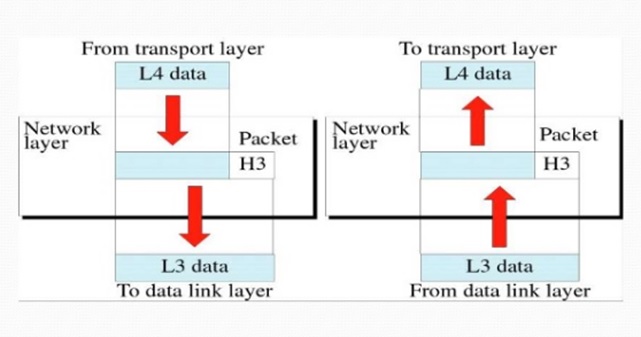计算机网络osi七层模型
什么是网络层? (What is Network Layer?)
The main aim of the Network Layer the source-to- destination delivery of a packet across multiple networks (links). Whereas the data link layer oversees the delivery of a packet between two systems on the same network (links), the network layer ensures that each packet gets from its source to its final destination.
网络层的主要目标是跨多个网络(链接)的数据包从源到目标的传递。 数据链路层负责监督同一网络(链路)上两个系统之间的数据包传递,而网络层则确保每个数据包均从其源到达其最终目的地。
It also breaks the messages that have to be sent into packets and to assemble incoming packets into messages for higher levels.
它还将必须发送的消息分解为数据包,并将传入的数据包组合为更高级别的消息。
If two systems are attached to the same network, there is usually no need for a network layer.
如果两个系统连接到同一网络,通常不需要网络层 。
However, if two systems are attached connecting devices on the different networks (links), so there is often needed for the network layer to complete the source-to-destination delivery of the message.
但是,如果连接了两个系统以连接不同网络(链接)上的设备,则网络层通常需要完成消息的源到目标传递。
This figure shows the relationship of the network layer to the data link and transport layer,
该图显示了网络层与数据链路和传输层的关系,

Network Layer
网络层
网络层的设计问题 (Design Issues with Network Layer)
A major design issue in the network layer is to determine the packet routing that is how each packet routed from source to destination.
网络层的主要设计问题是确定数据包路由,即每个数据包如何从源路由到目标。
Routes can be based on static tables and also highly dynamic that is each packet has a predefined route or it can be changed for each packet.
路由可以基于静态表,也可以是高度动态的,即每个数据包都具有预定义的路由,或者可以针对每个数据包进行更改。
If there are too many packets are available in the subnet at the particular time, they will get into one another's way, forming bottlenecks.
如果在特定时间子网中有太多可用的数据包,它们将进入彼此的方式,形成瓶颈。
The network layer issue is the quality of service provided such as delay, transmit time, jitter, etc.
网络层问题是所提供的服务质量,例如延迟,传输时间,抖动等。
When packet travel from one network to another to reach its destination, many problems can arise such as:
当数据包从一个网络到达另一个网络到达目的地时,可能会出现许多问题,例如:
- The addressing being used by two networks may be different from each other.
- It is necessary to have different protocols.
网络层的责任 (Responsibilities of the Network layer)
Following are the responsibilities of the Network layer:
以下是网络层的职责:
1. Logical Addressing
1.逻辑寻址
In the internet world, there are two kinds of addressing implemented by the data link layer, it handles addressing problems locally.
在互联网世界中,数据链路层实现了两种寻址,它可以本地处理寻址问题。
If the network passes through the network boundary, we need another system to distinguish source and destination systems.
如果网络穿过网络边界,我们需要另一个系统来区分源系统和目标系统。
The logical addressing at the network layer while physical addressing at the data link layer is defined by the MAC address of a device, whereas the IP addressing is determined at the network layer of the OSI model. This addressing is also called as logical addressing.
在网络层的逻辑寻址,在数据链路层的物理寻址,是由设备的MAC地址定义的,而IP寻址是在OSI模型的网络层确定的。 此寻址也称为逻辑寻址。
The network layer adds a header to the packet which is coming from the upper layer includes the logical addresses of the sender and receiver.
网络层将报头添加到来自上层的数据包,其中包括发送方和接收方的逻辑地址。
2. Routing
2.路由
When two independent networks or links are attached to create an internetwork that is the network of networks or a large network, the connecting devices route the packets to its destination.
当连接两个独立的网络或链接以创建网际网络(即网络网络或大型网络)时,连接设备会将数据包路由到其目的地。
The forwarding of the data request to servers is known as routing.
将数据请求转发到服务器称为路由。
3. Fragmentation and Reassembly
3.碎片和重组
The network layer must send data down to the data link layer for transmission. The data or information that the network layer receives is in the form of a packet and the data that data link layer forwards is called a frame.
网络层必须将数据向下发送到数据链路层进行传输。 网络层接收的数据或信息采用分组的形式,数据链路层转发的数据称为帧。
The network layer has the responsibility of Fragmentation and reassembly because some data link layer technologies have limits on the length of any message that can be sent.
网络层负责分段和重组,因为某些数据链路层技术对可发送的任何消息的长度都有限制。
If the packet of data that the network layer has to send is too large, the network layer must break the packet up, send each packet to the data link layer, and then have pieces reassembled once they arrive at the network layer on the destination system.
如果网络层必须发送的数据包太大,则网络层必须将其分解,将每个数据包发送到数据链路层,然后在到达目标系统的网络层后重新组装它们。
Example:
例:
If I want to access some data from Facebook then I will open my laptop, type URL of Facebook and send an HTTP request to facebook.com for some data.
如果我想从Facebook访问一些数据,那么我将打开我的笔记本电脑,键入Facebook的URL并将HTTP请求发送到facebook.com以获取一些数据。
Since the server of Facebook is situated outside my local area network, my request is forwarded to Facebook through the default gateway or router of my institution.
由于Facebook的服务器位于我的局域网之外,因此我的请求将通过我机构的默认网关或路由器转发给Facebook。
翻译自: https://www.includehelp.com/computer-networks/functions-of-network-layer-in-the-osi-model.aspx
计算机网络osi七层模型







 网络层在OSI模型中负责跨多个网络的数据包从源到目标的传递,解决路由选择、逻辑寻址和数据包的碎片与重组等问题。它还确保在不同网络间通信时的数据包正确传输,同时处理网络拥塞和服务质量。
网络层在OSI模型中负责跨多个网络的数据包从源到目标的传递,解决路由选择、逻辑寻址和数据包的碎片与重组等问题。它还确保在不同网络间通信时的数据包正确传输,同时处理网络拥塞和服务质量。














 5552
5552

 被折叠的 条评论
为什么被折叠?
被折叠的 条评论
为什么被折叠?








